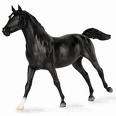What makes one rider better than the other? How do you measure talent in a rider? These are very good questions that I get asked quite often. I believe a rider can be taught many, many things, such as position, style, horsemanship, and strategy, but the one thing that is nearly impossible to teach is the rider's eye for a distance. You either have it or you do not. Michael Jordan had "it," in a different sport, yes, but, he had it. Alex Rodriguez has "it" in baseball, Beezie Madden has "it" in riding.
So what is it in our sport of show-jumping? I believe it is the rider's eye for a spot or distance. The ability to judge a take off place from a top a horse from quite a ways a way is very difficult, and very few riders get this naturally. A rider with talent, will naturally "see" distances, and are able to judge what they need to do to adjust to those distances. A rider without an eye will struggle to gain this perspective, and often miss their distances.
All riders can improve, but it is far easier to teach the child who has a natural eye than one that does not. Strength of position can be drilled with constant repetitive practice. Ring savvy comes from ring experience, or just showing a great deal, the will to win can even be instilled, but the innate talent of riding comes from that ability to judge distance. Yes, you can rehearse and practice and find that you do have an eye, many young riders do not show promise at first, but all of a sudden reach a riding epiphany and can finally see. It is like the blind man who tells his doctor, "hey, I think I am seeing some light when I wake up in the morning." Just because you do not seem to have it at first does not mean you will never get it, but if you are going to be a talented rider, either by hard work, or good luck, the ability to judge a distance is already a part of your D.N.A. Michael Jordan was not a good basketball player at first, in fact he was cut from his high school team his freshman year. Yet Jordan had that secret ingredient, the talent, the eye, and when you combine talent with practice, you get greatness.
There are thousands of good riders out there, many with talent. The great ones are the ones that have that ability, and work to bring it out. I have also seen riders with little natural talent succeed through tremendous hard work and brain power. Take what you are given and develop it into riding success, if you do not think you have a good "eye," work at it, practice, you might be delighted to suddenly realize that you can see a distance. Just because you "keep missing," does not mean that won't stop, and just because teaching someone to see is very difficult, does not mean that it is impossible.
I do believe that talent lies within the ability to see a distance. I also believe that with hard work you can bring out what great amounts of talent you are blessed with, or develop what little talent you might have. Either way, once you are out in the show ring, you are judged on your ability to see, and the good riders do not miss much.
By Alan Korotkin
Alan Korotkin has over twenty years of experience in the horse business, his clients have won over 150 year end south Florida riding titles, and he himself has placed in over 150 grand prix competitions. He can be contacted at http://www.castlewoodfarmsales.com
Article Source: http://EzineArticles.com/?expert=Alan_Korotkin
Read More..



